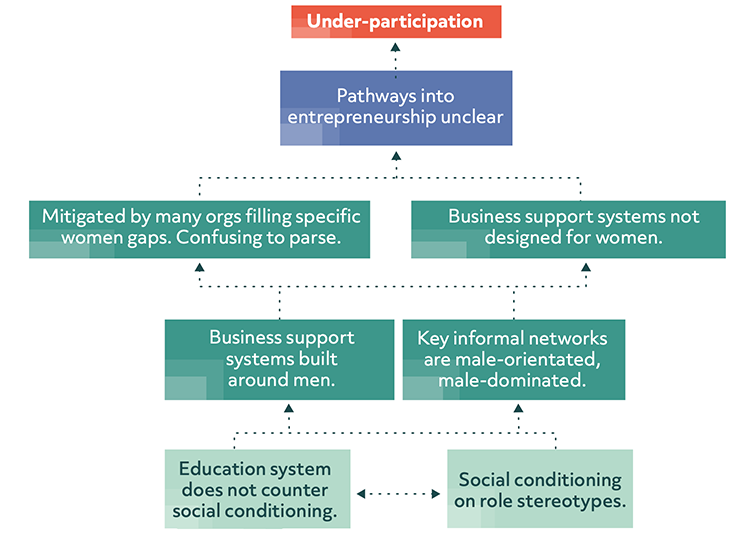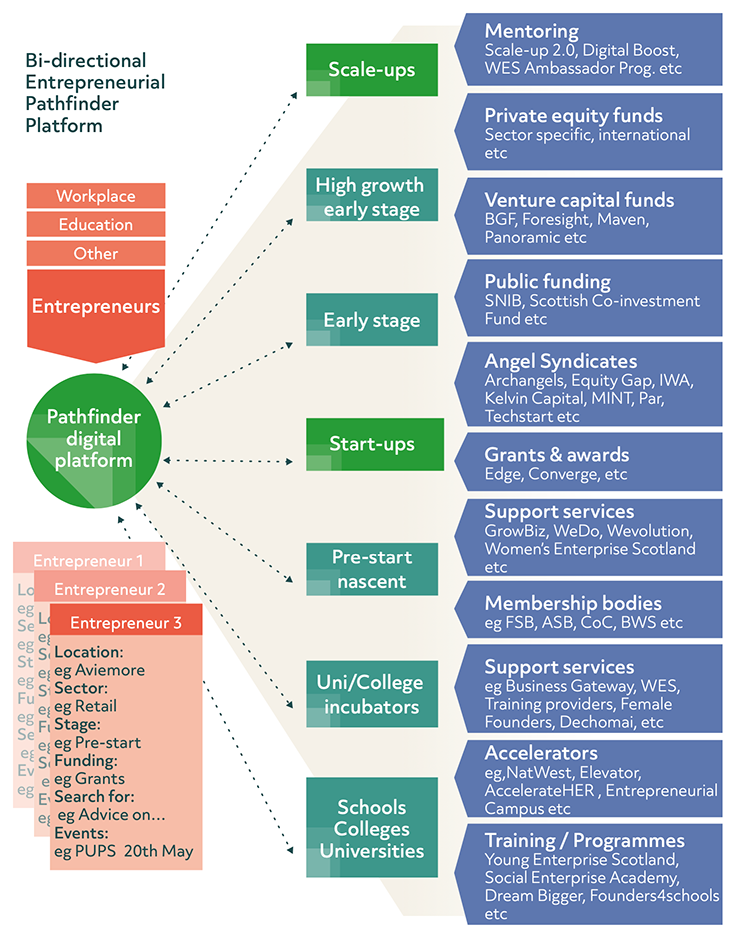Pathways: A new approach for women in entrepreneurship
An independent review into women in entrepreneurship in Scotland, authored by Ana Stewart and Mark Logan. Based on thorough data analysis and stakeholder engagement the report's recommendations seek to address the root causes of female under-participation in entrepreneurship.
06. Pathways into entrepreneurship are unclear or unavailable
In this chapter, we explore the following proximate cause of female under-participation in entrepreneurship:
Formally defined pathways into entrepreneurship are unclear, while informal pathways and networks underserve women.
Existing pathways into and within entrepreneurship largely operate on an informal, network-based support model. These provide advice, expertise, introductions to investors and more. Of course, such networks have been shaped by the same root causes described earlier; intensive societal conditioning on what constitutes "normal" gender roles and the fact that the education programmes – from birth to adulthood – required to intensively counter and correct this conditioning, are largely absent from our society.
These have the effect of producing largely male-dominated informal networks, which suffer from the proximate cause described in Chapter 5 (a sense of not belonging for women), which reduces their availability to women. And, because the entrepreneurial ecosystem relies on these informal networks, alternative support mechanisms for women are under-invested in, under-coordinated and under-scaled.
"As a female founder I do not feel 'plugged in' to the informal networks that may exist, nor have much visibility of such networks" - Caroline Barelle, CEO & Founder, Elasmogen
Other support systems aren't configured to support the specific needs of women (see Chapter 4, women are logistically highly constrained). For example, access-points into entrepreneurships, incubators etc., are often located in urban centres, which is problematic for primary-carers.
In reaction to this general situation, various point mitigations have been introduced; for example, support groups for women entrepreneurs, women-only incubators, women-oriented investment funds, etc. These individual endeavours are not well coordinated, in recognition of the others' existence. More generally, the early-stage start-up space is a cluttered environment, consisting of literally hundreds of organisations, including support groups, government agencies, accelerator hubs, mentoring groups, training programmes, incubators, members associations, chambers of commerce, etc. The combination of their sheer number, the informality of their operating models and the degree of overlap between them is confusing and often intimidating for entrepreneurs, who report finding it difficult to parse these options or to navigate the entrepreneurial pathways available to them.
In our Entrepreneurial Voice Survey, approximately 77% of respondents stated that there was a lack of signposting and clear pathways for their entrepreneurial journey. Of those interviewed, many felt that they were being passed between multiple organisations, before eventually ending up where they started. One described a sense of being "on a merry go round that isn't going anywhere", unable to unlock the door to the next stage of the entrepreneurial journey.
We can summarise the cause-and-effect relationships between these various mechanisms as follows (reading from bottom to top):

Addressing the Causes
"When I first started my Starling journey I was not aware of the Angel or early stage entrepreneurial community. It was neither visible nor easy to navigate. Strong and cohesive signposting that makes this environment more accessible to more entrepreneurs can only be a good thing." - Anne Boden, Founder & CEO, Starling Bank
No comprehensive, overall entrepreneurial pathways framework and journey mapping currently exists[57]. Instead, various public and privately funded organisations provide partial journey maps[58], with little coordination existing between them.
Therefore, the obvious action is to create a centralised resource with clearly defined pathways for entrepreneurs at various stages of their individual journeys, in each case making clear the follow-on support and mentoring options available to them. Of course, the value of such a resource would not be limited only to female founders – all participating demographics would benefit. However, given that the present situation is particularly unsuited to women (because their access to informal entrepreneurial knowledge-network is more limited), supporting women should be prioritised in the development of this resource. For the remainder of this discussion, we'll refer to this resource with the working title of Entrepreneurial Pathfinder.
For such an endeavour to work, we must take account of several important considerations. For example, given the sheer number of supporting organisations, and the resulting pathways, Entrepreneurial Pathfinder should be context-sensitive rather than presenting all available pathways and expecting entrepreneurs to locate themselves correctly within the map. The latter approach would defeat the purpose of the exercise. Instead, we envision Entrepreneurial Pathfinder being delivered as a digital platform that can properly locate entrepreneurs at the right point within the support map, based on information supplied by the user. In essence, each entrepreneur is presented with their own journey based on their current circumstances, providing a "golden-thread" through the potential support options available to them.
"Stronger supply chains, collaboration and structured on-going support and pathways are essential to help female start-ups." - Jackie Brierton, Founder Growbiz
The figure below depicts a (not complete) view of the support available to founders, reinforcing this need to make parsing this landscape easier.

Entrepreneurial Pathfinder must contain all credible support resources, both public and privately owned. To ensure that this is the case, it must be developed and maintained by an impartial entity, with digital expertise at its core. Such an organisation could, for example, be selected through a tender process, with impartiality a demonstrable condition of contract[59]. Otherwise, the tendency to bias towards one's own offerings and deprecate others will, over time, be too great. The responsible organisation for Entrepreneurial Pathfinder must actively maintain the currency and completeness of entrepreneurial support information within the service from the nascent start-up stage to high growth potential stage.
This solution would not only provide customised, relevant guidance to individual founders, it should also eventually form part of a wider national start-up ecosystem digital platform, spanning applicable Scottish and UK-wide resources and services. Some countries already operate key components of such a platform, bi-directionally connecting all start-ups in the country with all angel investors grant bodies etc.
For example, Israel is already providing centralised access to entrepreneurs and Investors through its Start-Up Nation platform[60]. New Zealand has launched a similar solution[61] and Canada's Women's Entrepreneurship strategy includes a centralised collaborative digital knowledge hub which connects women with support services at a local level[62]. It may be no coincidence that these three countries lead the world in female entrepreneurship[63].
We also recommend that any public funding provided to entrepreneurial support organisations is contingent on active engagement with the Entrepreneurial Pathfinder operating team, ensuring that information is up to date, etc.
For illustration of how the Entrepreneurial Pathfinder could support entrepreneurs, consider the following, typical scenario:
Jane Doe lives in Aviemore and is a single parent who has two young children. She works part-time but has a business idea that she thinks has potential. She downloads the Entrepreneurial Pathfinder app, which, through a chatbot conversation, discovers that Jane is a very early-stage entrepreneur living in Aviemore. It alerts her to the Pop-Up Pre-Start currently operating at her local school. When she drops her children at school, she drops in before she heads off to work, to find out more.
This is her first entry point into the entrepreneurial ecosystem. Resources already outlined in Chapter 4 then become available to her. The blend of local physical and digital support and guidance gives her the courage to apply for a Concept Fund micro-grant to test her nascent idea. She is successful in her application.
She further uses the Entrepreneurial Pathfinder app to provide visibility of potential next steps for supporting her business, with future potential finance options as well as access to other key resources to help her understand what is involved. The information is customised for Jane, based on her specific business sector and location. The app links her to other existing organisations such as the local development agency, accelerators, networking group and local and private or public digital training initiatives that may help her to create her first product version. It also presents her with details of all the organisations and providers that are currently operating in her local ecosystem that may be relevant to her situation.
For example, as a recipient of the Concept Fund she is alerted to the follow-on Journey Fund and a list of relevant angel syndicates, as well as possible HIE grant support and other Award options such as Scottish Edge.
The Entrepreneurial Pathfinder will continue to adjust the guidance presented to Jane as her business develops through its early stages.
The above proposals are presented as specific recommendations in Chapter 10.
Contact
Email: EIDEEBSPEnquires@gov.scot
There is a problem
Thanks for your feedback